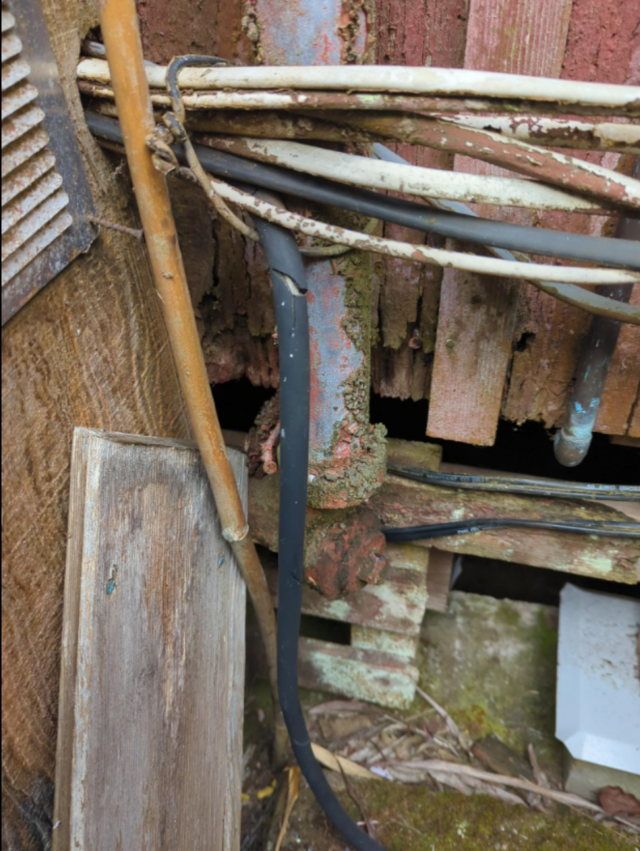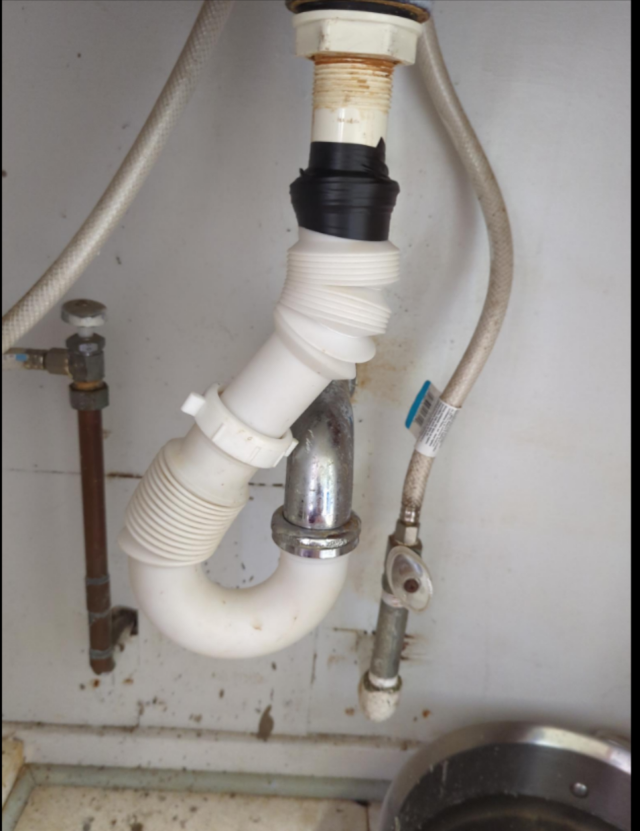Fortunately, though the island place is 110 years old, most of the plumbing is at least a bit newer. I’m not sure when the bathroom sink was installed, but evidence points to that part of the house being built in the early 1930’s (though the fixtures and the hot water piping and much newer). The drain clogged yesterday, so I went to work. I had been putting off doing the new plumbing down at the studio for a few weeks now, so I suppose now being forced to deal with old plumbing might be seen as a kind of karma. (I am not particularly fond of plumbing work.)
The problem wasn’t up in the trap, which was a creative mix of old iron, newer chrome, and even newer PVC including a flexible connector between the sink drain and the p-trap that was bent at impressive angles. I regret not taking a picture of it. Nonetheless, that isn’t where the problem was, so I thought I’d attack at the cleanout.

As you can see, the cleanout is old, rusted, painted, surrounded by old, dry, rotted wood and, yes, those are electrical wires (Romex) outside and in direct contact with the pipe. I put a wrench on the cleanout. It wouldn’t budge. I put a bigger wrench on the cleanout. No motion. I put four feet of pipe over the wrench handle and did a pull-up on it: about 800 ft-pounds of torque. No motion. Oh, yes, I had sprayed it with WD-40 some time before. It wasn’t moving.
The only way I’ve ever freed up a stuck fitting like that is to put a torch to it. The heat will usually help move things along. But with the pipe in direct contact with 110 year-old wood and out-of-code electrical wiring, adding fire seemed like a bad idea.
Instead, I removed the p-trap and fed the snake in through there. It was a tough feed in a very cramped space and my snake really needs to be replaced. I’m not sure how it got so kinked, but kinked it was. In the end, though, the snaking did the job (unlike when the kitchen sink clogged, and we ended up simply cutting the pipe out and replacing it). When I connected everything back together, though, I discovered that the flexible PVC pipe connecting the sink to the p-trap now had eight cracks in the pleats of the flex tubing. Sigh. The reason for the contortion is that the horizontal pipe is too long. Like the cleanout, though, the horizontal has welded itself to the old lead wastepipe and won’t yield even to my 18” pipe wrench. I would have to remove the cabinetry to put any more torque on it.
I took a trip down the mountain to the small but remarkably well-stocked hardware store. They had a whole pegboard display of waste pipe parts and, as near as I could tell, only one item had an empty hangar and was out-of-stock. You already know, of course, that the only out-of-stock item was the 1¼” flexible downpipe that I needed. I bought the wrong-sized (1½”) one that they had in stock, and a new p-trap with a flexible section I thought might accommodate it. As it turns out, with a lot of contortions I was able to make it work, though I believe I’ve now earned a lifetime ban from the plumbers’ union.

Yes, that’s some black PVC tape holding part of it together, though it’s actually a tight force fit and the tape is just for backup. I’d drive to the big-town hardware stores tomorrow, but I’m actually planning to completely remodel the bathroom soon anyway, and I think my Rube Goldberg drain will hold up until then.
—2p
addendum 2024-10-20
For those concerned about the wiring, that isn’t even the worst of it. I’m already re-wiring the entire house with a whole new service panel (the old one is a notorious Stab-Lok).